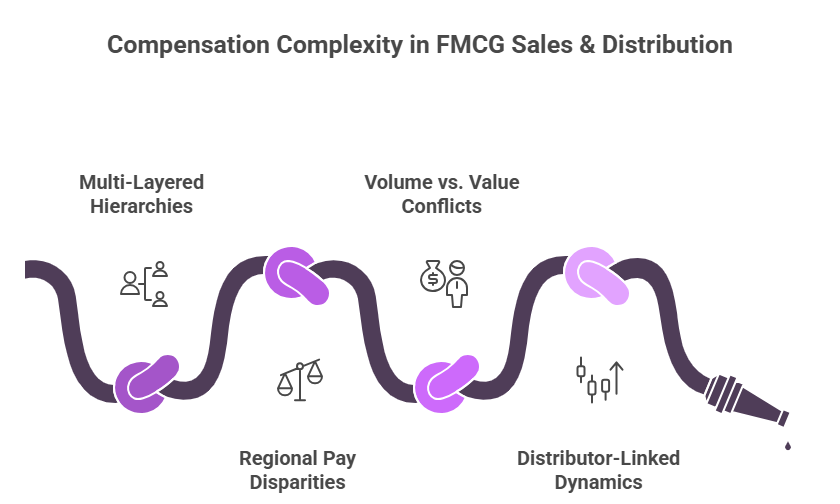The FMCG and food & beverage industries thrive on scale, speed, and execution, all driven by vast sales and distribution networks. From territory sales officers to regional heads and merchandisers, the success of every product launch, shelf placement, and order fulfillment depends on how effectively these on-ground teams are motivated and rewarded.
However, legacy pay structures, inconsistent incentive systems, and regional disparities often dilute motivation and efficiency. Many companies continue to rely on uniform compensation models that fail to reflect market performance, cost variations, or individual contribution levels.
As competition intensifies and margins tighten, leading FMCG players are turning toward compensation benchmarking to bring data-backed precision to their pay frameworks. Nexdigm’s Compensation Benchmarking Consulting helps organizations design optimized, performance-aligned, and regionally adaptive pay structures, ensuring sales excellence, workforce stability, and sustainable growth across dynamic distribution ecosystems.
The Complexity of Compensation in FMCG Sales & Distribution
The FMCG ecosystem operates through multi-tiered and geographically dispersed sales networks, making compensation alignment both critical and challenging. Pay structures must not only drive performance but also maintain fairness across territories, distributors, and market conditions.

- Multi-Layered Sales Hierarchies: From field executives to zonal managers, each level drives distinct outcomes, yet many organizations apply uniform incentive models that fail to capture varying contribution levels. This leads to inefficiencies and underperformance in strategic markets.
- Regional Pay Disparities: Compensation competitiveness differs sharply between urban and rural markets, influenced by cost of living, distribution complexity, and regional productivity rates. Without benchmarking, organizations risk overpaying in low-demand zones and losing talent in high-growth regions.
- Volume vs. Value Conflicts: Traditional incentive systems often prioritize sales volume over profitability, resulting in short-term gains but weak margin control. Benchmarking helps balance incentives toward strategic metrics like revenue quality, outlet coverage, and distribution efficiency.
- Distributor-Linked Dynamics: Incentive structures are further complicated by indirect sales networks involving distributors and retail partners. Misaligned channel incentives can erode trust and reduce collaboration.
The result is a pressing need for data-driven compensation benchmarking that provides visibility into market realities, ensures pay fairness, and drives targeted performance across FMCG networks.
Nexdigm’s FMCG Compensation Benchmarking Framework
Building an effective pay structure in FMCG and food & beverage enterprises demands a data-driven approach that aligns workforce performance, market dynamics, and business goals. Nexdigm’s FMCG Compensation Benchmarking Framework is designed to bring structure, transparency, and precision to how sales and distribution roles are rewarded.
- Sales Role Mapping and Standardization: FMCG companies operate with layered sales structures, from territory sales executives and merchandisers to regional managers and key account leads. Nexdigm’s framework standardizes these roles through detailed job family mapping, ensuring that each position is benchmarked accurately against comparable functions across geographies. This provides clarity in career progression, pay differentiation, and incentive logic.
- Regional Compensation Analytics: Compensation competitiveness in FMCG is highly regional. Pay benchmarks vary across Tier-I, Tier-II, and rural markets, influenced by labor dynamics, logistics complexity, and local productivity levels. Nexdigm’s benchmarking engine normalizes these variations, allowing leadership teams to calibrate pay bands and incentives that remain fair, cost-efficient, and performance-driven across markets.
- Incentive Structure Optimization: Traditional incentive structures often overemphasize volume-based sales, overlooking profitability, distribution depth, and strategic KPIs. Nexdigm redesigns incentive mechanisms to balance short-term achievement with long-term business health, integrating measurable indicators like net revenue contribution, outlet activation, and product mix optimization.
- Performance and Productivity Integration: Nexdigm’s model incorporates data-backed KPIs such as call efficiency, coverage expansion, order frequency, and ROI per outlet into compensation design. This ensures that pay is not only competitive but directly correlated with measurable outcomes, reinforcing accountability and performance transparency across the sales ecosystem.
- Governance and Transparency: To maintain compliance and credibility, Nexdigm embeds governance parameters into compensation planning. This includes pay equity audits, ESG-linked performance metrics, and standardized review cycles, enabling organizations to foster fairness, regulatory alignment, and trust among distributed sales teams.
Through this framework, Nexdigm helps FMCG and food & beverage organizations transform compensation from an operational necessity into a strategic advantage. By connecting pay with measurable performance, market data, and ethical governance, companies can achieve higher retention, sharper productivity, and sustained growth across their nationwide distribution networks.
To take the next step, simply visit our Request a Consultation page and share your requirements with us.
Harsh Mittal
+91-8422857704

